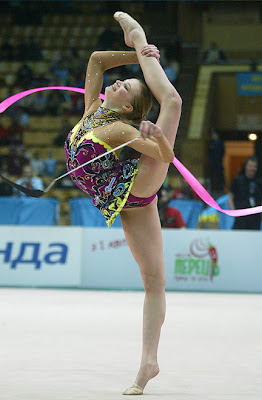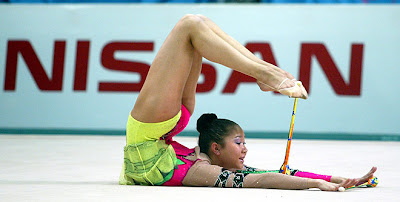

Rhythmic gymnastics is a sport in which single competitors or pairs, trios or even more manipulate one or two apparatuses: Ball, Clubs, Hoop, Ribbon, and Rope. It combines elements of ballet, gymnastics, theatrical dance, and apparatus manipulation. The victor is the participant who earns the most points, as awarded by a panel of judges, for leaps, balances, pivots, flexibility, apparatus handling, and artistic effect.
The sport's governing body, the Fédération Internationale de Gymnastique (FIG), changed the Code of Points in 2001, 2003 and 2005 to emphasize technical elements and reduce the subjectivity of judging. Before 2001, judging was on a scale of 10 like that of Artistic Gymnastics. It was changed to a 30-point scale in 2003 and in 2005 was changed to 20. There are three values adding up to be the final points—technical, artistic and execution.
International competitions are split between Juniors, under sixteen by their year of birth ; and Seniors, for girls 16 and over again by their year of birth. Gymnasts typically start training at a very young age and those at their peak are typically in their late teens or early twenties. The largest events in the sport are the Olympic Games, World Championships, and Grand-Prix Tournaments.
Rhythmic gymnastics is largely a sport for women and girls, but a growing number of men participate in a few countries. The Japanese's version of men's rhythmic gymnastics includes tumbling and is performed on a spring floor. Points are awarded based a 10-point scale that measures the level of difficulty of the tumbling and apparatus handling. Individuals compete in four types of apparatus: rope, stick, double rings, and clubs. Groups do not use any apparatus. Japan hosted the first men's world championships in 2003, drawing teams from Canada, Korea, Malaysia, and the United States.









